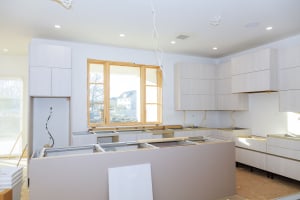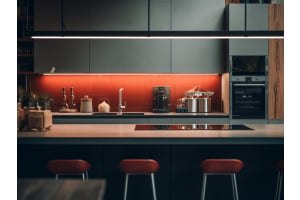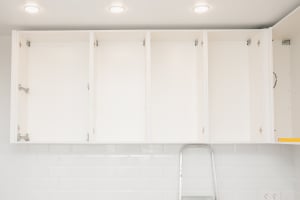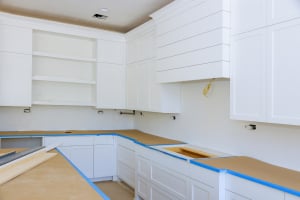Designing your new kitchen cabinetry can be a fun, creative process, but designing the flow and functionality of your modern kitchen cabinet doors is just as important to consider.
There are a few factors that go into determining the swing of your cabinet doors such as–the layout and purpose of each cabinet, the appliances, and the kitchen space itself. When all of these factors go into consideration, the result is an intuitive storage space that flows with your design vision.
Working in Pairs
Generally, most cabinets are designed in pairs. For each pair, there is one cabinet door that has hinges on the left hand side with a door pull on the right, while the other door has hinges on its right hand side with a pull on the left.
Each door mirrors the other. If you were to open both cabinet doors at the same time they would open out and away from one another. When considering how to protect kitchen cabinet doors, working in pairs as often as possible will help prevent two cabinet doors from colliding into one another.
Single Cabinets
While pairs are fairly standard, not every layout can accommodate an even number of pairs. You may have a lone cabinet or two.
Here’s where functionality really matters. Let’s say your pair has a lone third cabinet beside it–does it work better for your kitchen space to have the door swing towards the other cabinets or towards the space on the other side?
If there is a wall on the other side, consider whether opening towards the wall will cause any damage to the door or paint with frequent use. Perhaps changing the position of the single cabinet makes the door swing more efficiently and with limited ability to cause damage to the paint or door.
Hardware
Door pull placement can influence door swing greatly. Aesthetically, you may prefer your door pulls to be placed along the center edge of the cabinet door. Consider how high or low the cabinet is sitting. If the cabinet sits higher, reaching for a higher door pull may result in putting strain on the hinges and pulling the door out of alignment. At that point, you’ll have to readjust the hinges to stop the cabinet door from opening on its own.
A potential solution would be to put the pulls towards the lower corner edge, closer to the person opening or closing the cabinet. The same goes in reverse–the lower the cabinet, the higher pull placement.
Working With the Space
You may have obstacles to navigate when determining your cabinet door’s swing. If your kitchen is a high-traffic area in your home, make practical decisions that won’t cause disruptions to how you use your kitchen. For example, appliances and walking paths might impact your decision making.
When in doubt, stand in your space and imagine opening your cabinets to reach for things while you cook. Have someone walk into the space while you are creating a visual map of your cabinetry layout. Always go with the best choice for your lifestyle needs!













